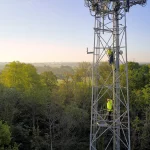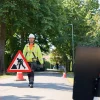EU Reveals 2025 Gigabit Broadband and 5G Coverage Progress vs UK

The European Commission (EC) recently published their annual 2025 study of broadband coverage in Europe, which reveals how the EU’s fixed gigabit broadband (FTTP and Hybrid Fibre Coax) and 5G mobile networks compare across all of its 27 countries. We compare this with the United Kingdom below.
The EU’s main target for digital infrastructure, which remains very similar to the UK’s, is for every European household to have access to “high-speed internet” (downloads of 100Mbps+) coverage by the end of 2025 and gigabit (1000Mbps+) connectivity by the end of 2030. The new report, which is largely based on data from last year (mid-2024), is intended to help gauge the progress toward achieving those goals.
The EU’s Broadband and Mobile Targets (“Digital Decade“)
The current vision for 2025 relies on three main strategic objectives:
➤ Gigabit connectivity for all of the main socio-economic drivers;
➤ uninterrupted 5G coverage for all urban areas and major terrestrial transport paths;
➤ access to connectivity offering at least 100 Mbps for all European households.
The ambition of the Digital Decade is that by 2030:
➤ all European households are covered by a Gigabit network (e.g. DOCSIS 3.1 + FTTP);
➤ all populated areas are covered by 5G (at least).
By comparison, the UK’s £5bn Project Gigabit programme currently aims to extend gigabit-capable broadband to reach 99% of UK premises by 2032 (recently delayed from the original goal of 2030). The public funding for this is focused upon aiding the final 10-20% of hardest to reach premises, where commercial deployments may struggle.
Advertisement
According to Ofcom’s latest data to January 2025 (here), some 98% of UK premises can access a 30Mbps+ (“superfast“) connection (up from 97% last year), while 86% (up from 80%) are able to access gigabit broadband (via FTTP and DOCSIS 3.1+) and that falls to 74% (up from 62%) when only looking at “full fibre” FTTP. Take note that, in the UK, DOCSIS 3.1 largely reflects Virgin Media’s urban Hybrid Fibre Coax (cable) network.
As for mobile networks, over 99% of UK premises (outdoor) have access to 4G (unchanged) and between 92-96% of premises can access 5G from at least one operator (up from 85-92%) – falling to just 22-44% in outdoor 5G areas where all four operators exist (up from 16-28%). However, it’s important to stress that the EU’s comparative data below is about 6 months older than Ofcom’s data above.
Overall, the EU is now in a roughly similar sort of place to the United Kingdom, with total FTTP coverage of 69.24% (up from 64% last year), gigabit (VHCN) broadband coverage of 82.49% (up from 78.8%) and 5G population coverage of 94.35% (up from 89.3%). But we do have to remember that quite a few EU states have been building FTTP, at scale, for 5-10 years longer than the UK, although we’re clearly now catching up and even exceeding quite a few countries.
The main focus of the EU’s report is clearly on 5G and gigabit / VHCN (FTTP + DOCSIS 3.1) coverage, with the differences between EU states and the UK becoming much clearer in these areas once we drill down to the individual country level. In both cases, the UK would now reside somewhere around the middle of the tables below.
Advertisement

The other thing to consider is the split between rural and urban coverage. In the UK, some 57% of rural premises have access to a gigabit-capable broadband network, which drops to 55% for FTTP. By comparison, gigabit (VHCN) coverage of rural areas in the EU stands at 61.89%, with FTTP at 58.78%.
The full report contains a lot more data.
Broadband Coverage in Europe 2025 (State of Digital Decade)
https://digital-decade-desi.digital-strategy.ec.europa.eu/datasets/desi/charts
Mark is a professional technology writer, IT consultant and computer engineer from Dorset (England), he also founded ISPreview in 1999 and enjoys analysing the latest telecoms and broadband developments. Find me on X (Twitter), Mastodon, Facebook, BlueSky, Threads.net and Linkedin.
« Vodafone UK Boost 4G Data Allowances on SIM Only Basics Plans






















































What is superfast coverage in the EU vs the 98% in the UK Mark?
I couldn’t find a clear result for that, but it was 92.9% last year (superfast being 30Mbps+) and so I’d estimate they’d be at 94% this year – given the prior rate of progress.
5G coverage by country shows you it’s a complete regulatory clown show.
Maybe Romania is less corrupt…
You wish.
I am traveling through EU every year by car, the coverage issue in UK is clearly based on low masts very often covered by trees or buildings that haven’t been there 20 years ago when they erected those masts. Also very often existing masts are not being upgraded to cover new estates. Not to mention that having UKs sim in roaming I am getting easily +200Mbps in 4G and 600Mbps on 5G in continental Europe. In the UK, operators are not fulfilling the contract they agreed to after receiving the frequency reservation, thereby breaking it, and OFCOM is doing nothing about it. What’s more, they are demanding tax breaks in order to fulfill this contract.
I agree with “Name”, but the issue is often planning and objections in the UK meaning our masts are much lower, below the tree line and most buildings, rather than buildings sprouting around existing masts. It’s planners, not operators who would much rather be able to build bigger masts.
Non-technical council planners will often say yes to a mast as long as it can’t be seen over the tops of nearby trees and structures, which for a mast in the GHz bands (pretty much line-of-sight reception) is silly. Go even to Ireland and you will see much taller masts and better coverage in general.
Unbelievable that Germany is so far down the list at rolling out FTTP but from what I can gather it’s pretty typical of how their public infrastructure has been allowed to decay in the last 15 years or so.
Red tape obstacles are a real thing
People make fun of Japan for still using fax but there was a very insightful interview of Elon Musk and German leader of the opposition Alice Weidel where in order to open Gigafactory Berlin, they had to literally deliver a TRUCK full of paper work to the German bureaucracy because nothing could be digital. Until the establishment gets ousted it won’t change
Lots of direct in ground cable leaving DT sweating copper as hard as they could for as long as they could. Proper build only started very recently.
Slovakia and Latvia are quite small countries as so I am surprised they have such poor networks.
It does not surprise me that Romania is doing so well. As once these Eastern European countries joined the EU, billions of Euros were handed over to them. This is still taking place. So some of the vast sums of money is being spent on infrastructure.
Not really. Romania’s fibre was built with private sector money. Their market leader started full fibre build in 2006.
I’m in Hatfield and still waiting xD
I found the report on gigabit broadband and 5G coverage in Europe really insightful! It’s interesting to see how the UK stacks up against the EU. I hope we can catch up soon!
I have been to Romania many times, it is so beautiful but the locals all boast about how their lives have completely changed due to the EU giving them basically a blank cheque for FTTP and infrastructure. This is seen all over E Europe.
Whatever the locals say doesn’t change that the EU didn’t pay for their largest FTTP provider, Digi’s, build as far as I can tell.
I’m sure it’s funded roads and bridges a plenty given they’ve received a hundred billion euro since 2007.
But but but, don’t our politicians constantly say the UK is well ahead and leading the world in so many industries and ways? I’m confused 😉